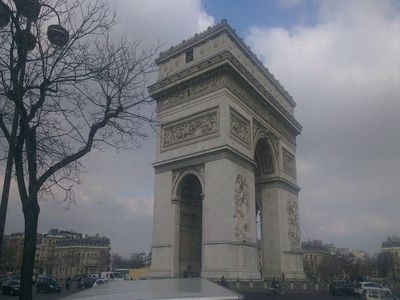Search Results
Rivers
Please select your preferred river
Rivers
Idyllic River Cruises
From the spectacular Danube to the majestic Rhine, discover the stunning rivers and waterways of Europe with our brilliant range of river cruises. Featuring fantastic ports of call, hop on board a comfortable and elegant ship and watch the incredible, ever-changing landscapes pass you by.
Cruise Ships
Please select your preferred cruise ship
Ships
Railways
Please select your preferred railway experience
Railways
Remarkable Rail Experiences
From the legendary Glacier Express to the colourful Yellow Train, our rail experiences turn journeys into highlights, pairing comfort with changing views across mountains, rivers and historic towns.
These scenic rides add amazing moments to your holiday, showcasing Europe’s beauty in the most relaxing way.
Pace
To help you choose the right tour for your comfort and pace, we've included a simple guide showing the level of physical activity involved in each holiday.
Pace
Finding the right Rail Holiday for you
EASY - holidays travelling solely by Eurostar or involving one train change. These tours involve minimal changes - usually just one train journey or one change in each direction. You'll need to be comfortable walking for 10-20 minutes and carrying your own luggage on and off trains.
MODERATE - holidays involving a minimum of two train changes. Ideal if you're happy with a bit more movement. These tours may include at least two train changes, and you should be able to walk for 30-40 minutes, possibly including stairs and platform changes, while managing your own luggage.
ACTIVE - holidays involving three or more train changes. Great for those who enjoy a more active travel experience. These tours can involve three or more train changes and require walking for at least 40 minutes,including stairs and station transfers. You'll need to carry your own luggage throughout.
Travel Options
Select your travel option from below
Outbound & Inbound Travel
Search using your town name below or select using the departure points list
Leicester Birmingham Rainham South Mimms Services Colchester Ashton Under Lyne Preston Loughton Chester Hemel Hempstead Romford Blackburn Oldham Scarborough Widnes Guildford Southend Basildon Huddersfield Luton Southampton Wakefield Watford Wetherby Services Brentwood Bury Cheshunt Cleveleys Harrogate Leeds Letchworth Northampton Sunderland Birkenhead Llandudno Junction Middlesbrough Newcastle under Lyme Newcastle upon Tyne Portsmouth Stafford Stockport Stockton Accrington Blackpool Burnley Hatfield Havant Stevenage Welwyn Garden City Hartlepool Liverpool Rayleigh Wigan Bolton Dartford Halifax Keighley Lichfield London Victoria Pickering Basingstoke Bournemouth Bromley Chorley Frankley Services Macclesfield Nantwich Nuneaton Prestatyn Rhyl Rochdale Runcorn Southport St Helens Wallasey Warrington Eastleigh Leigh Milton Keynes Northallerton Altrincham Bradford Dewsbury Durham Manchester Pontefract Prescot Selby Solihull Abergele Bedford Bristol Cheadle Colwyn Bay Crewe Formby Sale Sandbach Services Coventry Fareham Hilton Park Services Lancaster Paignton Ripon Tamworth West Bromwich Wolverhampton Bishop Auckland Chester Le Street Darlington Gateshead Knaresborough Newton Aycliffe Thirsk Warwick York Aldershot Banbury Croydon Reading Ringwood Gravesend Hoddesdon Maidenhead Rugby Sutton Coldfield Woking Wrexham Taunton Cardiff Chieveley Services Gloucester Newport Bootle Bracknell Camberley Cheltenham Farnborough High Wycombe Slough Staines Washington Exeter Bexleyheath Gordano Services Maidstone Orpington Rotherham Weston Super Mare Hounslow Stroud Sutton Uxbridge Bridgwater Chatham Dudley Newton Abbot Redhill Torquay Bromsgrove Kidderminster Hereford Christchurch Redditch Swansea Totton Barnsley Doncaster Worcester Stourbridge Bridgend Cardiff West Services Ross on Wye Enfield Worksop Chesterfield Clacton On Sea Leatherhead Sedgemoor Services Sheffield Twickenham Leicester Forest East Services Mansfield Norwich Nottingham Lincoln Hinckley Dunstable Epping Hertford Ware Witham Northwich Woodall Services Chester Services Coalville Walsall Ashby De La Zouch Derby Morecambe Pudsey Congleton Leyland Watford Gap Services Maidstone Services Brighouse Llangefni Shipley Ashford Beaconsfield Stop 24 Services Stratford Upon Avon Uttoxeter Cobham Services Oxford Grays Knutsford Services Lymm Services Mold Rawtenstall Plymouth Clacket Lane Services Caterham Chelmsford Winchester Services Fleet Carmarthen Chepstow Llanelli Medway Pavilion Services Poole Pontypridd Eastbourne Brighton Hull Neath Burton Upon Trent Cwmbran Abingdon Hopwood Park Services Ipswich Wimborne Minster Worthing Chichester Halesowen Yeovil Ferrybridge Cambridge Chippenham Donington Park Services Gillingham Harlow Kingston upon Thames Magor Services Kings Lynn Salisbury Surbiton Retford Cardiff Gate Services Crosby Alfreton Barnet Bath Bognor Regis Epsom Peterborough Services Port Talbot Driffield Ellesmere Port Stamford Blackpool Airport Ely Lowestoft Telford Urmston Wymondham Beverley Huntingdon Market Harborough Scunthorpe Shrewsbury Attleborough Bridlington Old Swan Spennymoor Stowmarket Bamber Bridge Bury St Edmunds Eccles Litherland Maghull Mexborough Ormskirk Wythenshawe Cleethorpes Cosham Crawley Diss Dronfield Leeming Bar Services Long Eaton Malton Wellingborough Heanor Kettering Belper Cirencester Gainsborough Newmarket Sutton in Ashfield Kidlington Loughborough Doncaster Services Sleaford Swadlincote Boston March Soham Spalding St Neots Thetford Didcot Garforth Kirkby Nelson Newbury Rickmansworth St Albans Thurrock Services Leighton Buzzard Birchanger Green Services Cullompton Services Pease Pottage Services Tunbridge Wells Stratford Canterbury Braintree FAVERSHAM Sudbury Swindon Aylesbury Bexhill on Sea Folkestone Grimsby Hastings Rugby Services Winchester Blyth Services Broadstairs Dover Hythe Kendal Scotch Corner Birchington Carlisle Carshalton Felixstowe Halstead Harrow Herne Bay Hitchin Lancaster Services Sittingbourne Strood Tonbridge Cannock Castleford Ramsgate Rochester Warwick Services Whitstable Barking Chingford Mount Cleckheaton Dagenham Eltham Golders Green Hornchurch Horsham Lewes Margate Newark Services Penrith Redbridge Ruislip Sevenoaks Swanley Upminster Waltham Abbey Biggleswade Leigh Delamere Services Peterborough Allerton Barrow in Furness Hanley Kidsgrove Moreton Queensferry Caerphilly Corby Middleton Billingham Castle Bromwich Goole Grantham Services Warndon Aintree Ashton-in-Makerfield Atherton Bromborough Holywell Hunts Cross Sandbach Swinton Walkden Walton Bangor Bearwood Dalton in Furness Dawlish Fordsham Frome Hessle Hyde Leek Membury Services Skegness Stourport Ulverston Weymouth Brigg Bulwell Clay Cross Louth Northampton Services Northfield Skipton Wisbech Arnold Barry Bourne Burgess Hill Deal Great Yarmouth Illminster Abergavenny Andover Beckenham Beeston Cradley Heath Denton Ealing East Grinstead Fleetwood Flitwick Gosport Great Barr Guisborough Hailsham Haverhill Malvern Melton Mowbray Pontypool Royal Leamington Spa Sheerness South Shields Stone Thickthorn Services Trowbridge Walton on Thames Witney Beccles East Dereham Hucknall Kenilworth Kingstanding Shirley Wellington Bletchley Corringham Gorleston Oswestry Royston Warminster Aldridge Amersham Bedworth Billericay Bispham Borehamwood Calne Catford Chapeltown Charnock Richard Services Chertsey Chesham Corley Services Cottingham Devizes Dorchester Dorking Downend Farnworth Filey Godalming Harpenden Haywards Heath Horncastle Hove Huyton Ilford Ilkeston Kings Heath Larkfield Leominster Littlehampton Ludlow Lutterworth Morley Northwood Hills Oakham Peterlee Potters Bar Ripley Romsey Rugeley Rushden Seaford Severn View Services Sheldon Sidmouth Tadcaster Tiverton Towcester Tring Waterlooville West Cliff On Sea Westhoughton Winsford Carnforth Cramlington Gorseinon Whitley Bay Atherstone Barnstaple Heathrow Airport Toddington Services Heckmondwike Gosforth Manchester Airport New Malden Oxford Peartree Services Downham Market Dereham Grantham Plymouth Ferry Terminal / Plymouth Holyhead Newcastle Airport Bristol Airport Edinburgh Airport Stansted Airport Birch Services Farnham Feltham Polegate Services Sunbury on Thames Copdock Services Gatwick Airport Norton Canes Services Flint Llandudno Woolley Edge Services Boreham Services Hartshead Moor Services Leeds - Skelton Lake Services Tibshelf Services Bingley Burley in Wharfdale Cross Hills Elland Horsforth Ilkley Immingham Menston Moortown Washington Services Yeadon Colchester Services Gretna Green Merthyr Tydfil Kettering Services Newcastle Terminal SwaffhamHoliday Type
Please select multiple holiday types
Popular Holidays
Seasonal Holidays
Special Interest Holidays
Search using your town name below or select using the departure points list
Leicester Birmingham Rainham South Mimms Services Colchester Ashton Under Lyne Preston Loughton Chester Hemel Hempstead Romford Blackburn Oldham Scarborough Widnes Guildford Southend Basildon Huddersfield Luton Southampton Wakefield Watford Wetherby Services Brentwood Bury Cheshunt Cleveleys Harrogate Leeds Letchworth Northampton Sunderland Birkenhead Llandudno Junction Middlesbrough Newcastle under Lyme Newcastle upon Tyne Portsmouth Stafford Stockport Stockton Accrington Blackpool Burnley Hatfield Havant Stevenage Welwyn Garden City Hartlepool Liverpool Rayleigh Wigan Bolton Dartford Halifax Keighley Lichfield London Victoria Pickering Basingstoke Bournemouth Bromley Chorley Frankley Services Macclesfield Nantwich Nuneaton Prestatyn Rhyl Rochdale Runcorn Southport St Helens Wallasey Warrington Eastleigh Leigh Milton Keynes Northallerton Altrincham Bradford Dewsbury Durham Manchester Pontefract Prescot Selby Solihull Abergele Bedford Bristol Cheadle Colwyn Bay Crewe Formby Sale Sandbach Services Coventry Fareham Hilton Park Services Lancaster Paignton Ripon Tamworth West Bromwich Wolverhampton Bishop Auckland Chester Le Street Darlington Gateshead Knaresborough Newton Aycliffe Thirsk Warwick York Aldershot Banbury Croydon Reading Ringwood Gravesend Hoddesdon Maidenhead Rugby Sutton Coldfield Woking Wrexham Taunton Cardiff Chieveley Services Gloucester Newport Bootle Bracknell Camberley Cheltenham Farnborough High Wycombe Slough Staines Washington Exeter Bexleyheath Gordano Services Maidstone Orpington Rotherham Weston Super Mare Hounslow Stroud Sutton Uxbridge Bridgwater Chatham Dudley Newton Abbot Redhill Torquay Bromsgrove Kidderminster Hereford Christchurch Redditch Swansea Totton Barnsley Doncaster Worcester Stourbridge Bridgend Cardiff West Services Ross on Wye Enfield Worksop Chesterfield Clacton On Sea Leatherhead Sedgemoor Services Sheffield Twickenham Leicester Forest East Services Mansfield Norwich Nottingham Lincoln Hinckley Dunstable Epping Hertford Ware Witham Northwich Woodall Services Chester Services Coalville Walsall Ashby De La Zouch Derby Morecambe Pudsey Congleton Leyland Watford Gap Services Maidstone Services Brighouse Llangefni Shipley Ashford Beaconsfield Stop 24 Services Stratford Upon Avon Uttoxeter Cobham Services Oxford Grays Knutsford Services Lymm Services Mold Rawtenstall Plymouth Clacket Lane Services Caterham Chelmsford Winchester Services Fleet Carmarthen Chepstow Llanelli Medway Pavilion Services Poole Pontypridd Eastbourne Brighton Hull Neath Burton Upon Trent Cwmbran Abingdon Hopwood Park Services Ipswich Wimborne Minster Worthing Chichester Halesowen Yeovil Ferrybridge Cambridge Chippenham Donington Park Services Gillingham Harlow Kingston upon Thames Magor Services Kings Lynn Salisbury Surbiton Retford Cardiff Gate Services Crosby Alfreton Barnet Bath Bognor Regis Epsom Peterborough Services Port Talbot Driffield Ellesmere Port Stamford Blackpool Airport Ely Lowestoft Telford Urmston Wymondham Beverley Huntingdon Market Harborough Scunthorpe Shrewsbury Attleborough Bridlington Old Swan Spennymoor Stowmarket Bamber Bridge Bury St Edmunds Eccles Litherland Maghull Mexborough Ormskirk Wythenshawe Cleethorpes Cosham Crawley Diss Dronfield Leeming Bar Services Long Eaton Malton Wellingborough Heanor Kettering Belper Cirencester Gainsborough Newmarket Sutton in Ashfield Kidlington Loughborough Doncaster Services Sleaford Swadlincote Boston March Soham Spalding St Neots Thetford Didcot Garforth Kirkby Nelson Newbury Rickmansworth St Albans Thurrock Services Leighton Buzzard Birchanger Green Services Cullompton Services Pease Pottage Services Tunbridge Wells Stratford Canterbury Braintree FAVERSHAM Sudbury Swindon Aylesbury Bexhill on Sea Folkestone Grimsby Hastings Rugby Services Winchester Blyth Services Broadstairs Dover Hythe Kendal Scotch Corner Birchington Carlisle Carshalton Felixstowe Halstead Harrow Herne Bay Hitchin Lancaster Services Sittingbourne Strood Tonbridge Cannock Castleford Ramsgate Rochester Warwick Services Whitstable Barking Chingford Mount Cleckheaton Dagenham Eltham Golders Green Hornchurch Horsham Lewes Margate Newark Services Penrith Redbridge Ruislip Sevenoaks Swanley Upminster Waltham Abbey Biggleswade Leigh Delamere Services Peterborough Allerton Barrow in Furness Hanley Kidsgrove Moreton Queensferry Caerphilly Corby Middleton Billingham Castle Bromwich Goole Grantham Services Warndon Aintree Ashton-in-Makerfield Atherton Bromborough Holywell Hunts Cross Sandbach Swinton Walkden Walton Bangor Bearwood Dalton in Furness Dawlish Fordsham Frome Hessle Hyde Leek Membury Services Skegness Stourport Ulverston Weymouth Brigg Bulwell Clay Cross Louth Northampton Services Northfield Skipton Wisbech Arnold Barry Bourne Burgess Hill Deal Great Yarmouth Illminster Abergavenny Andover Beckenham Beeston Cradley Heath Denton Ealing East Grinstead Fleetwood Flitwick Gosport Great Barr Guisborough Hailsham Haverhill Malvern Melton Mowbray Pontypool Royal Leamington Spa Sheerness South Shields Stone Thickthorn Services Trowbridge Walton on Thames Witney Beccles East Dereham Hucknall Kenilworth Kingstanding Shirley Wellington Bletchley Corringham Gorleston Oswestry Royston Warminster Aldridge Amersham Bedworth Billericay Bispham Borehamwood Calne Catford Chapeltown Charnock Richard Services Chertsey Chesham Corley Services Cottingham Devizes Dorchester Dorking Downend Farnworth Filey Godalming Harpenden Haywards Heath Horncastle Hove Huyton Ilford Ilkeston Kings Heath Larkfield Leominster Littlehampton Ludlow Lutterworth Morley Northwood Hills Oakham Peterlee Potters Bar Ripley Romsey Rugeley Rushden Seaford Severn View Services Sheldon Sidmouth Tadcaster Tiverton Towcester Tring Waterlooville West Cliff On Sea Westhoughton Winsford Carnforth Cramlington Gorseinon Whitley Bay Atherstone Barnstaple Heathrow Airport Toddington Services Heckmondwike Gosforth Manchester Airport New Malden Oxford Peartree Services Downham Market Dereham Grantham Plymouth Ferry Terminal / Plymouth Holyhead Newcastle Airport Bristol Airport Edinburgh Airport Stansted Airport Birch Services Farnham Feltham Polegate Services Sunbury on Thames Copdock Services Gatwick Airport Norton Canes Services Flint Llandudno Woolley Edge Services Boreham Services Hartshead Moor Services Leeds - Skelton Lake Services Tibshelf Services Bingley Burley in Wharfdale Cross Hills Elland Horsforth Ilkley Immingham Menston Moortown Washington Services Yeadon Colchester Services Gretna Green Merthyr Tydfil Kettering Services Newcastle Terminal SwaffhamDeparture Date
When would you like your holiday to begin?
Calendar Key
Select Departure Month(s)
How flexible are you?
Duration
Select how long you wish to go on holiday for
Duration Key
*Duration may not be available depending on your current search criteria
Coach Type
Select one or more coach types

Luxuria: The equivalent of business class, state-of-the-art Luxuria is the ultimate way to travel.
- Deluxe, armchair-style seats
- Every seat has its own, fully interactive, touch-screen T.V.
- Selection of double and single seats
- Servery on board
- Climate control
- Plug sockets and USB points

Silver Service: Elegant and stylish, Silver Service offers added comfort and fantastic facilities.
- Specially designed reclining seats
- Spacious rear lounge
- Onboard entertainment and satellite navigation system
- Free personal headphones
- Personal tables

Executive: Executive coaches are modern and comfortable, ensuring a relaxing journey.
- Air-conditioning
- Reclining seats
- Servery on board
- Onboard toilet
Price/Budget
Please select price by Passenger or Total and your preferred budget
Use the pricing tool below:
You have selected £0 - £10000 per person
Use the pricing tool below:
You have selected £0 - £30000 per person
Passengers
Enter the number of adults
Your Drivers
Please select which drivers you would like to travel with.
Find your next holiday
Last-Minute Holidays
Look forward to a holiday departing soon!

Tasty Mexican BBQ Chicken Enchilada Recipe
This cheesy, saucy BBQ chicken dish is a great alternative to fajitas for those tortilla wraps lurking in your cupboard!

Be Brave With Your Breaks: Top Travel Tips from Dr David Lewis
Be Brave With Your Breaks: Top Travel Tips from Dr. David Lewis

Introducing our New Tour: Grand Scenic Austria
Snow-capped mountain peaks, luscious green hillsides, and crystal blue lakes are just some of the images conjured up...

If at first you dont succeed dance cut short sur le Pont dAvignon
Passing through neat rows of grapevines and rolling green fields stretching as far as the eye could see.

The 24 Hours of Le Mans - See it live!
The 24 Hours of Le Mans has been held annually since 1923 near the town of Le Mans in France.

Italian Sud Tyrol & the Dolomites - A Passengers View
Amazing, Beautiful, Spectacular, Wonderful, Fantastic, Stunning.

Disneyland Paris by Coach for Halloween
Ashley Rastrick, Leger's Senior Web Designer, has been designing Leger's websites for the past four years and recentl...

Interesting facts about Italy
Interesting Facts About Italy Italy is a country rich in history, culture, and natural beauty. Here are some fascina...

Paris Midweek and Weekend Breaks by Coach
Richard Mansfield, Leger's E-commerce Executive, has been working at Leger for just over four months now.

New Archeological Excavations - The Juno Beach Centre
Planning a visit to Normandy in 2014?

Easy Traditional Christmas Mince Pie Recipe
Christmas at home isn't for everyone as some like to escape on our Christmas holidays, but for you at home, here is a...

Barnsley Pals: Following in the Footsteps of Local Heroes
Our Head Battlefield Guide, Paul Reed, has lived in the South Yorkshire former mining village of Elsecar for the past...

The Three Best Cities to Visit in Denmark
Denmark is the southernmost Scandinavian country and consists of the Jutland Peninsula and over 400 islands, some of...
We offer flexible payment options
Once you have booked your tour either online, or by telephone 01709 787 463 , you have the flexibility of how you pay off the remainder of your balance. You can:
- Use our balance payment facility online to make and track your card payments. You can pay as much as you want up until your final due date or pay it all, the choice is yours.
- Send payments via online banking.
- Send payments via cheque.
- Call us and make a card payment, either a small amount or as lump sum until your final due date.
Our contact and online banking payment details will be on your confirmation invoice to remind you of your choices.









